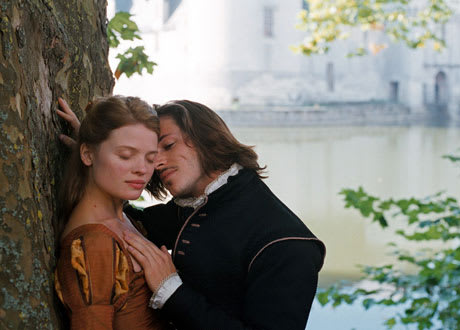I guess it's always been a "French thing" to take standard adaptations of period literature and inject their own brand of film politics, defying conventions, utilizing Brechtian subterfuge and denying catharsis as a mode of forcing analysis or challenging the audience to question expectations. And for some reason, when people like Catherine Breillat or Eric Rohmer do it, tossing actresses with bleached hair, tattoos and breast implants into an 18th Century formula, it actually works.
But Bertrand Tavernier isn't interested in making such a dramatic or self-conscious statement with the 1662 Madame de La Fayette adaptation, The Princess of Montpensier, instead maintaining the details and likely reality of the times without normalizing or embellishing them with modernity. Unfortunately, this also means that he avoids saying or doing anything, omitting score, cinematography and close-ups, essentially making a film that avoids exploiting its medium altogether. And while this all has a point, the reality is that we gain nothing from watching the film that we wouldn't have from reading the script or hearing a brief synopsis.
Plot-wise, this lethargic, ugly corset drama unfolds during the Protestant/Catholic conflicts in France during the 16th Century. Clumsily directed battle sequences divide up the core story of feminine exploitation and punishment for defiance, with Marie de Mézières (Mélanie Thierry) settling into a strategic, clinical marriage to Philippe, Prince de Montpensier (Grégoire Leprince-Ringuet), despite her affections for Henri, Duc de Guise (Gaspard Ulliel).
Her actuality and spirit are defined and revealed with an older teacher, the Comte de Chabannes (Lambert Wilson), whose love for the girl encourages her fiery, unconventional shortcomings after her husband leaves to fight in one of many battles.
Now, this could all work as a parable of female agency, integrating the essentially abnormal reality of accurate renaissance. But the cold, expository nature and flat, low angle cinematography make it chore to learn a lesson of placated audience expectations that really isn't quite as insightful as Tavernier seems to think it is.
(Paradise)But Bertrand Tavernier isn't interested in making such a dramatic or self-conscious statement with the 1662 Madame de La Fayette adaptation, The Princess of Montpensier, instead maintaining the details and likely reality of the times without normalizing or embellishing them with modernity. Unfortunately, this also means that he avoids saying or doing anything, omitting score, cinematography and close-ups, essentially making a film that avoids exploiting its medium altogether. And while this all has a point, the reality is that we gain nothing from watching the film that we wouldn't have from reading the script or hearing a brief synopsis.
Plot-wise, this lethargic, ugly corset drama unfolds during the Protestant/Catholic conflicts in France during the 16th Century. Clumsily directed battle sequences divide up the core story of feminine exploitation and punishment for defiance, with Marie de Mézières (Mélanie Thierry) settling into a strategic, clinical marriage to Philippe, Prince de Montpensier (Grégoire Leprince-Ringuet), despite her affections for Henri, Duc de Guise (Gaspard Ulliel).
Her actuality and spirit are defined and revealed with an older teacher, the Comte de Chabannes (Lambert Wilson), whose love for the girl encourages her fiery, unconventional shortcomings after her husband leaves to fight in one of many battles.
Now, this could all work as a parable of female agency, integrating the essentially abnormal reality of accurate renaissance. But the cold, expository nature and flat, low angle cinematography make it chore to learn a lesson of placated audience expectations that really isn't quite as insightful as Tavernier seems to think it is.
